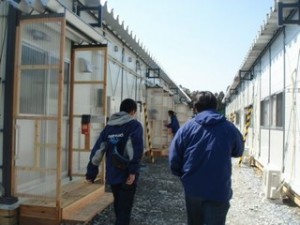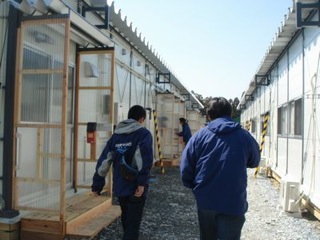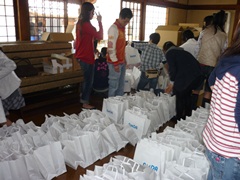 Various sources indicate that Japan has experienced over 900 aftershocks with about 60 over magnitude 6.0 and three over magnitude 7.0. Also in the news on the 12th was the announcement by the Japanese government that the nuclear crisis was even more serious than previously indicated. It raised the severity level from 5 to 7—the highest level possible.
Various sources indicate that Japan has experienced over 900 aftershocks with about 60 over magnitude 6.0 and three over magnitude 7.0. Also in the news on the 12th was the announcement by the Japanese government that the nuclear crisis was even more serious than previously indicated. It raised the severity level from 5 to 7—the highest level possible.
As temporary housing is now being set up in Iwate Prefecture, Peace Winds Japan (PWJ) has begun to coordinate with the prefectural authorities to gather and provide items that the disaster victims need for their daily lives. PWJ first confirms what types of items are needed, how many residences are being set up, and what ages and genders the residents will be, and then arranges the items accordingly.
On April 9, the first 36 homes were completed in Rikuzentakata (Iwate Prefecture) and families began moving in. They were thrilled to receive donations of goods that they could use right away. The items included shampoo, soap, towels, wash basins, kettles, pots and pans, clocks, first-aid kits, bedding, furniture, clothing, diapers, children’s clothing, etc. The estimate is that about 2,000 temporary homes will be built in Ofunato, 4,000 in Rikuzentakata, and 5,000 in Kamaishi.
AMDA reported that the electricity had come back on in some areas of Otsuchi, allowing street lights and traffic lights to operate once again and offering a ray of hope to the local residents, but large aftershocks knocked the electricity out once again, providing another emotional setback for the survivors.
Volunteers gathered at a temple in Okayama (home to AMDA) to organize packages of stationery to be delivered by AMDA to the disaster victims in Otsuchi and Kamaishi (Iwate Prefecture). The stationery was donated by high school students from Hiroshima for the evacuees to use in contacting their loved ones. In addition to providing ongoing medical services, AMDA set up a playroom for children and held a sporting event and a movie viewing to lighten the stress of the evacuees.


